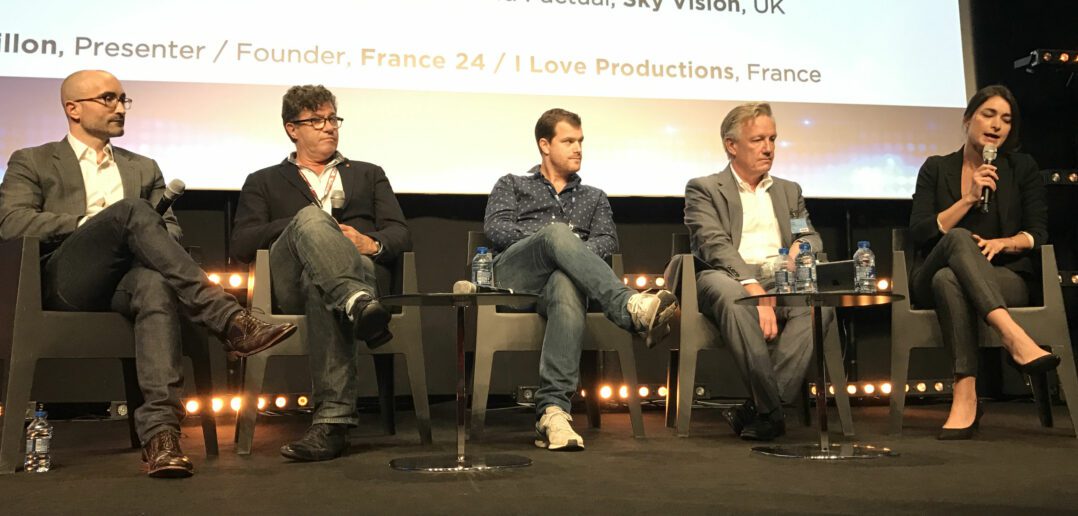We’ve heard a lot about the growth of people watching video on their smartphones, especially for younger viewers and YouTube. Today at MIPCOM, though, a session explored how iPhones are being used by production companies while making their projects.
The panel included Steven Bawol, MD of Helion Productions; Patrick Dedole, director and showrunner at Productions Tony Comiti; Rodolphe Guignard, head of pre-sales and co-productions at RMC Découverte; and Barnaby Shingleton, director of entertainment and factual at Sky Vision. The moderator was France 24 / I Love Productions’ Marjorie Paillon.
The focus was a project, Into The Fire, that involved filming the Marseilles Marine Firefighters Brigade. « We said okay, how is it possible to find a way for this film to catch the reality everywhere? So a different point of view for the viewers was the magical solution… 10 iPhones, » said Dedole. The team could travel quickly to fires by motorbike to film with those iPhones, rather than being slowed down by a classical camera setup – although one was used, too, for other scenes.
Bawol talked about shooting with GoPro cameras for avalanches and rockslides, which led him to thinking « there’s a new way of doing documentaries that’s more intimate and more authentic« , which in turn led on to the firefighters project. « We discussed the idea of using iPhones. It’s the same kind of quality but there’s more flexibility… it’s a new kind of documentary to do. »
According to Shingleton, Sky Vision invested in the project for the promise of delivering footage within a fire: « And you can only really do that with this technology… the promise of actually being able to see within a fire, being held by a fireman doing the job, was what sold it to me from an editorial perspective. And from a distribution perspective, the iPhone angle is very interesting from a promotional perspective. »
« It’s a new storytelling way, » said Guignard. « I think that now the audience needs to be more in the action. The documentary needs to be more immersive. And the only way to be into the action is to put an iPhone inside. An iPhone is much more flexible in terms of quality than a GoPro. You can change the focus by tapping on the screen. It’s a magical tool. And it breaks the distance between the characters and the crew. An iPhone is a daily tool for us: Everyone has one in their pocket. »
Dedole stressed: « The talent is not the iPhone. The talent is a cameraman. With an iPhone you are not a professional: you are a tourist, » he said. « Your relation with the reality depends on you. Technically, we are not here to say the revolution is there: we have the new way with Truffaut, Godard and so on!.. With iPhone it’s not a revolution: yes, everybody can shoot. There is no university for the talent. »
Guignard cited the importance of interactions between those being filmed and the crew, suggesting it’s a more natural interaction. « You can bring iPhones into situations where you could just not bring a camera out, » added Shingleton. « It’s about how your subject responds to the technology. »
Guignard pointed out that iPhone only accounted for 20% of the documentary – « It’s not the goal to say ‘see a documentary shot on an iPhone » – but all the key action sequences in the show were filmed this way. Dedole suggested that the debate on whether iPhone footage is high-quality enough for TV is over. « You can focus on the stories, the characters. After that, we never talk about technology, because we have the quality: it’s 4K, » he said. « I don’t think viewers care how it’s shot. They just want to have good content that they’ve never seen before, and that’s what the iPhone provides, » said Shingleton.
What about the audio? Dedole admitted that this was difficult: It had to be recorded separately. « I think sound is more important than the picture. If you have a very good sound, you can have bad quality; it’s better than very beautiful pictures and no sound. So that’s the new project now, » he said.
Bawol noted that the iPhone wasn’t developed for this kind of use, so the project surprised even Apple. « They were as amazed as anybody: we didn’t realise you could do this with these things. They’re just waking up to the fact that you’ve got this really powerful tool in there. Waking up to the fact that it’s something professionals are going to want to use. » He hopes Apple will help find solutions for the audio challenges, and said some iPhone apps dedicated to high-quality sound recording already exist.
Shingleton talked about iPhone-shooting bringing down costs, which opens up new creative possibilities. Guignard pointed to the fact that 80% of this particular show was shot on standard equipment, not iPhones, while Dedole suggested that the advantages are more about time than money: To be able to put an iPhone-toting team on the ground to focus on the quality, rather than leaving one (expensive) camera and crew in place for months. For a shoot that involves lots of travelling, iPhones can also save money on the transport costs.
« It gives you more production value. It makes a series that looks better, » said Bawol. « The programming that we’re up against is stuff from Discovery, NatGeo. Their budgets are three or four times ours. So one way we can be competitive is to use this technology and do stuff they haven’t done yet. It’s a way of punching above our weight. »
Dedole said it’s important to realise that this method is still in its early stages, and there are wrinkles to work out: For example, how cameramen feel about using an iPhone, rather than their familiar equipment. Younger assistants take to it more readily: « Old cameramen don’t want to be involved in that kind of technology, because they don’t feel professional [holding an iPhone instead of a camera], » said Dedole.
« The younger guys are used to it because they’re doing it all the time, » nodded Bawol. « The younger these guys are, the more they’re watching whatever they’re watching on their phones anyway. The idea that you could shoot with one is not a disconnect for them. It makes sense. »
Bawol again stressed that the iPhone is just a tool, and it’s still vital to have people who know how to use it, as well as people who know how to tell a story and run a show. « It boils down to, do you have the experience and the talent to make that idea into something people want to watch, » he said.
Will the higher echelons of the community truly respect projects shot with a smartphone? « It’s the story, the talent, what you want to show, what talent you have. That’s the most important thing. iPhone is just a little revolution; a change of generation, » said Dedole. « The new generation don’t think about this. They have something to say, they have something to show. They have an iPhone: they can put it on Facebook or YouTube; you can imagine iPhone Bollywood. It’s possible! »
« It’s such a new technology: everything is possible, » said Bawol, pointing out that, while this panel brings its experience to bear on how to use iPhone as a tool, the younger generation will find new formats and applications for this method of shooting.




